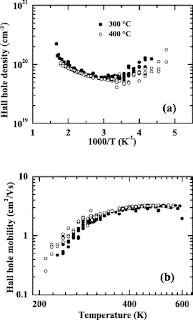Topics: Consumer Electronics, Economy, High Energy Physics, Ion Implantation, Semiconductors
Abstract
The processing parameters which favour the onset of an impurity band conduction around room temperature with a contemporaneous elevated p-type conductivity in Al + implanted 4H-SiC are highlighted by comparing original and literature results. In the examined cases, Al is implanted at 300–400 °C, in concentrations from below to above the Al solubility limit in 4H-SiC (2 × 1020 cm−3) and post implantation annealing temperature is ≥1950 °C. Transport measurements feature the onset of an impurity band conduction, appearing at increasing temperature for increasing Al implant dose, until this transport mechanism is enabled around room temperature. This condition appears suitable to guarantee a thermal stability of the electrical properties. In this study, the heaviest doped and less resistive samples (Al implanted concentration of 5 × 1020 cm−3 and resistivity of about 2 × 10−2 Ω cm) show a carrier density above the Al solubility limit, which is consistent with at least a 50% electrical activation for a 15% compensation. The model of Miller and Abrahams well describes the resistivity data of the lower doped sample, whereas a deviation from the behaviour predicted by such a model is observed in the higher doped specimens, consistent with the occurrence of a variable range hopping at low temperature.
Journal of Applied Physics:
Remarks on the room temperature impurity band conduction in heavily Al+ implanted 4H-SiC
A. Parisini1, M. Gorni1, A. Nath2, L. Belsito3, Mulpuri V. Rao2 and R. Nipoti3

Comments